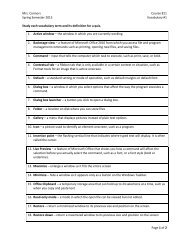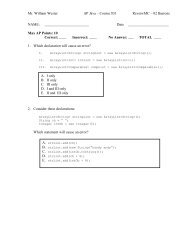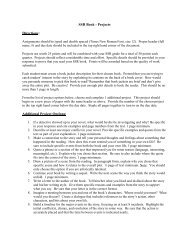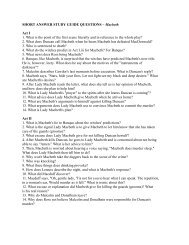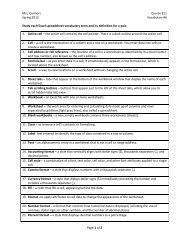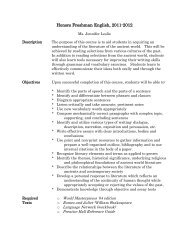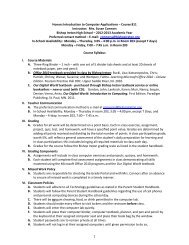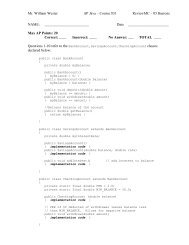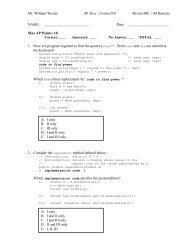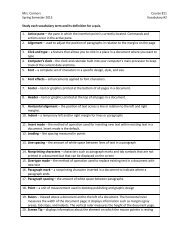Stability Across Cohorts in Divorce Risk Factors - Bishop Ireton High ...
Stability Across Cohorts in Divorce Risk Factors - Bishop Ireton High ...
Stability Across Cohorts in Divorce Risk Factors - Bishop Ireton High ...
You also want an ePaper? Increase the reach of your titles
YUMPU automatically turns print PDFs into web optimized ePapers that Google loves.
340 Demography, Volume 39-Number 2, May 2002<br />
Table 2. Estimates of Model Fit for Models Involv<strong>in</strong>g an Interaction Between Each Predictor<br />
Variable and Year Married<br />
Model χ 2 / df BIC<br />
Model Model χ 2 df Difference BIC Difference<br />
A: Basel<strong>in</strong>e Additive Model 2,929.58 22 –– –2,732.96 ––<br />
B: A + Age at Marriage × Year Married<br />
C: A + Husband’s Age at Marriage × Year<br />
2,933.14 23 3.56/1 –2,727.58 5.38<br />
Married 2,938.39 23 8.81/1 –2,732.83 0.13<br />
D: A + Premarital Birth × Year Married 2,933.14 23 3.56/1 –2,727.58 5.38<br />
E: A + Premarital Conception × Year Married 2,929.80 23 0.22/1 –2,724.24 8.72<br />
F: A + Wife Older × Year Married<br />
G: A + Wife Has More Education × Year<br />
2,930.51 23 0.93/1 –2,724.95 8.01<br />
Married 2,931.93 23 2.35/1 –2,726.37 6.59<br />
H: A + Husband Older × Year Married 2,939.01 23 9.43/1 –2,733.45 –0.49<br />
I: A + Wife’s Education × Year Married 2,932.22 23 2.64/1 –2,726.66 6.30<br />
J: A + Husband’s Education × Year Married 2,929.89 24 0.31/2 –2,715.40 17.56<br />
K: A + Catholic × Year Married 2,936.00 23 6.42/1 –2,731.44 1.52<br />
L: A + Wife’s Parents <strong>Divorce</strong>d × Year Married 2,931.14 23 1.56/1 –2,725.58 7.38<br />
M: A + Black × Year Married 2,953.24 23 23.66/1 –2,747.68 –14.72<br />
N: A + All Interactions With Year Married 2,980.33 35 50.75/13 –2,667.52 65.44<br />
Notes: All models <strong>in</strong>clude a control for survey round. N for the calculation of BIC is 7,611. Values <strong>in</strong> italic type are<br />
statistically significant at p < .05. Values <strong>in</strong> bold italic type show strong evidence us<strong>in</strong>g BIC for reject<strong>in</strong>g the null hypothesis of a<br />
zero effect.<br />
the husband be<strong>in</strong>g older, be<strong>in</strong>g Catholic, and be<strong>in</strong>g black. However, the BIC statistic <strong>in</strong>dicates<br />
only one <strong>in</strong>teraction with positive evidence that the null hypothesis of no change<br />
across time should be rejected: the effect of be<strong>in</strong>g black.<br />
The results for Model N, which simultaneously <strong>in</strong>cludes all <strong>in</strong>teractions with historical<br />
time, <strong>in</strong>dicate a significantly better-fitt<strong>in</strong>g model us<strong>in</strong>g the LR statistic but not the<br />
BIC statistic. Indeed, the substantial <strong>in</strong>crease <strong>in</strong> the BIC statistic <strong>in</strong>dicates that this model<br />
may be overparameterized (i.e., may conta<strong>in</strong> too many nonsignificant parameters). The<br />
<strong>in</strong>dividual coefficients from this model, however, are <strong>in</strong>structive: they <strong>in</strong>dicate that when<br />
all <strong>in</strong>teractions are considered simultaneously, the only significant <strong>in</strong>teraction, us<strong>in</strong>g either<br />
the LR or BIC statistic as the criterion, is that associated with be<strong>in</strong>g black (results<br />
not shown). This result provides further support for the notion that the only substantial<br />
<strong>in</strong>teraction with time <strong>in</strong>volves blacks.<br />
Hazard ratios from bivariate Cox regression models, the additive multivariate basel<strong>in</strong>e<br />
model (Model A <strong>in</strong> Table 2), and the model <strong>in</strong>clud<strong>in</strong>g the <strong>in</strong>teraction between year of<br />
marriage and be<strong>in</strong>g black (Model M <strong>in</strong> Table 2) are shown <strong>in</strong> Table 3. The hazard ratios<br />
shown (e β ) represent multiplicative effects on the hazard of marital dissolution at any<br />
marital duration. Hazard ratios greater than 1 <strong>in</strong>dicate a positive effect, and hazard ratios<br />
less than 1 <strong>in</strong>dicate a negative effect. The percentage difference <strong>in</strong> the risk of divorce at<br />
any marital duration associated with a unit change <strong>in</strong> a predictor variable can be calculated<br />
by subtract<strong>in</strong>g 1 from the hazard ratio and multiply<strong>in</strong>g by 100.




